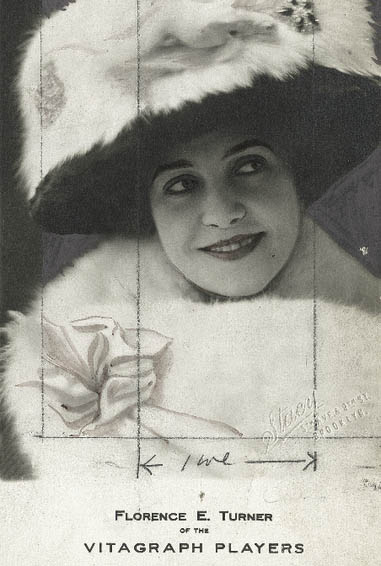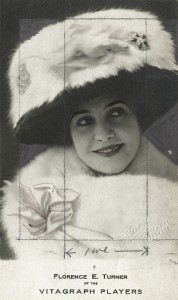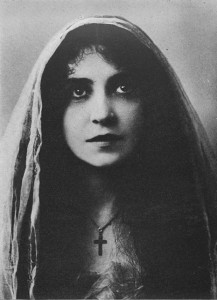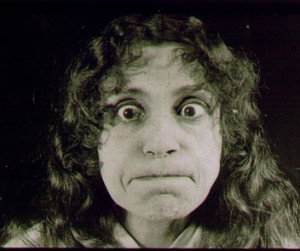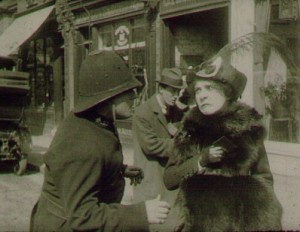This particular pioneer had a transcontinental career. As a result, her profile includes multiple essays by different authors.
Her American Career
By Charlie Keil
What did it mean to be a film star in the second decade of film’s existence, at a time when the idea of film stardom itself was just beginning to take shape? The career of Florence Turner offers an illuminating opportunity to consider this question, especially as she has been identified as one of the two “first big movie stars” (the other being Florence Lawrence) by no less an authority than Eileen Bowser (Bowser 1994). Aside from sharing the same first name, Turner and Lawrence both found themselves initially identified with the companies producing their motion pictures: Lawrence came to be known as “the Biograph Girl” while Turner gained fame as “the Vitagraph Girl.” The two were also among the first actors to make personal appearances in promotion of their films, ushering in an era when performers were enlisted to publicize themselves, thereby aiding in the emergence of cinema as an institution.
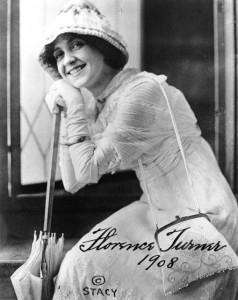
Publicity portrait, Florence Turner. Courtesy of the Academy of Motion Picture Arts and Sciences, Margaret Herrick Library.
As Richard deCordova has insightfully indicated, actors like Turner represented the first instance when appreciation of a film star derived from fan knowledge of that figure’s film performances rather than a star persona established within another popular medium, primarily the theatre (1990, 40). For that reason, Turner’s on-screen portrayals during her formative years at Vitagraph were probably more important to her stardom than any other element. Though not the only female performer of note at the studio, she was undoubtedly its most popular actress, and a number of the plum dramatic and comedic roles for women went to Turner until she left Vitagraph in 1913. In the years immediately following the formation of the Motion Picture Patents Company, Biograph and Vitagraph emerged as the most accomplished of the so-called Trust companies, but unlike its rival, Vitagraph was able to retain the services of its most prominent female star for several years. For that reason, despite the presence of other notable female performers including Julia Swayne Gordon, Rose Tapley, Clara Kimball Young, Lillian Walker, and, eventually, Norma Talmage, during Turner’s tenure at Vitagraph, she remained the face of the company for over five years.
A measurement of Turner’s prominence at Vitagraph can be taken when one considers the nature of her performances in a selection of her extant films. A skilled comedienne, Turner nonetheless excelled in dramatic roles that called upon her growing command of the developing verisimilar style perfected at Vitagraph during this time. In particular, reflexive roles casting Turner as an actress seemed designed to showcase her prodigious talent. In Renunciation (1910), for example, Turner plays a young woman whose fiancé’s father persuades her to discourage his son’s attentions by emulating a state of dissolution. The film’s success hinges on Turner’s ability to portray convincingly an actress giving a performance designed to deceive her diegetic audience, while at the same time prompting the film’s viewers to recognize both the persuasiveness of the performance and the true emotions the character experiences when engaged in the ruse. Possibly Turner’s most demanding role was the rejected lover in Jealousy (1911), a film now lost. Promoted by Vitagraph as “A Study in the Art of Dramatic Expression by Florence E. Turner,” the film was a tour de force for the actress, as she was the sole performer on-screen for the entirety of Jealousy’s running time. Her accomplishment led Vitagraph to proclaim that “this is a supreme exhibition of histrionic excellence that challenges Bernhardt and Mrs. Leslie Carter at their best” (“Special Vitagraph Feature” 8). Moving Picture World, in August 1911, stressed the centrality of performance to the effectiveness of the film: “[The actress] has the courage to let the truth be told in her countenance and movements. The audience gazes into the mystery of a human soul” (361).
Having joined Vitagraph at an early stage in its development, Turner gained the chance to mature with the company. According to some reports, she performed numerous duties there, including payroll and overseeing the other actors. Whether she involved herself in the creating of the films during this phase of her career is unknown; certainly she claimed to have written scripts when interviewed later in life, but did not specify whether this applied only to her post-Vitagraph endeavours in Britain. We can safely believe her when she says that “she was the first woman in America ever engaged as a permanent leading woman [in films].” And at one point she was undoubtedly the most popular motion picture actress in the US, receiving nearly 100,000 votes in a 1912 poll (more than double than what was earned by Mary Pickford).
Leaving America at the peak of her fame, Turner gained greater independence in Britain, forming the Turner Films Company in collaboration with Larry Trimble, who had directed her at Vitagraph. She enjoyed some success in Britain, releasing numerous films there before returning to the US for a brief period in the late teens and then going back to the UK for four more years. By the mid-1920s she had permanently relocated to Hollywood, but never recaptured the massive popularity she enjoyed prior to her initial departure, subsisting on bit parts for the remainder of her career. Though her ascendancy coincided with the very emergence of early film stardom itself, Turner never successfully moved beyond what deCordova would describe as a “picture personality,” a star defined principally by the strength of her performances (1990, 87). Fittingly, perhaps, Turner’s fame waned as cinema achieved the status of mass entertainment, abetted by a press-propelled star worship focused on off-screen scandals and carefully crafted personae that relegated her type of star image to an earlier era.
Her British Career
By Jon Burrows
In 1913, Florence Turner embarked upon an unprecedented new development in her career when she left Vitagraph, crossed the Atlantic and established her own production company, Turner Films, in Britain. She remained there for the next three years, appearing in ten shorts, mostly comedies, and sixteen feature film “exclusives.” Turner can thus be seen as the first American film star to become aware of, and capitalise upon, the international dimension of her burgeoning celebrity. Turner and her associates explained this dramatic move as a direct consequence of the stifling influence of the Motion Picture Patents Company upon the American film industry. She wanted to take control of her own career and establish herself as an autonomous agent, but felt that the current “trade factionalism” in the US created too many difficulties for independent producers. The UK, on the other hand, remained an open market in which there were no cartels dictating distribution practices.
The Turner Films operation rented the studio facilities and many of the stock company players of the Hepworth Manufacturing Company in Walton-on-Thames. The Vitagraph influence remained strong, however. Turner was joined in England by her former director Larry Trimble, her former co-star Tom Powers, and by “Jean the Vitagraph Dog.” She was also accompanied for the duration of her stay by her mother Frances Turner – herself a former Vitagraph actress, who appeared in at least one of Florence’s British films. Another significant continuity with Turner’s working life in America is represented by the numerous live appearances she made in British variety theaters and music halls. Turner was a gifted mimic and facial contortionist, and her act, which she first toured around US vaudeville theaters after leaving Vitagraph early in 1913, consisted of a series of caricatured imitations of various everyday character types and celebrities of stage and screen. In fact, she first announced her arrival in British cultural life on May 26, 1913, with a personal appearance at one of the West End’s premier variety theaters, the London Pavilion. Before any of her British films were ready for release, she then embarked upon a major nationwide tour of the theaters belonging to Britain’s biggest music hall syndicate, Moss Empires. It remains to be established if Turner had genuine ambitions to establish herself as a bona fide star of British vaudeville or whether she principally arranged such bookings as a lucrative means of publicizing her new film venture. Whatever the aims behind this strategy, she continued to tour throughout England, Scotland and Wales right up to the point of her return to New York in 1916. By so doing she can be considered as the first performer in the UK who was able to exploit a screen celebrity to launch a successful, although subsidiary, stage career.
There was no question of this eclipsing her popularity in the cinema, however. Even without the resources of Vitagraph behind them, Turner Films very effectively built upon the exposure Florence Turner had gained with her previous employers. In June 1914 she was voted Britain’s favourite female film star by readers of Pictures and the Picturegoer in the first such fan magazine popularity poll to be undertaken in the UK (358-359). Despite the increasing stranglehold on the British market which American film companies began to exercise during the First World War, Turner appears to have maintained an extremely high level of fame and recognition in her adopted country. In a 1915 Pictures and the Picturegoer poll she gained the runner’s up position behind Mary Pickford (112). A 1916 “Films Beauty Contest” run by the Picture Palace News placed her fourth in the nation’s affections (578).
A measure of Turner’s cachet at the local box office is demonstrated by the circumstances surrounding the production and exhibition of her 1915 film My Old Dutch. Although produced by Turner Films, My Old Dutch was commissioned and financed by Britain’s biggest distributor, Ideal, as a vehicle for the legendary music hall comedian Albert Chevalier, and it loosely dramatised his internationally famous “coster” song of the same name. It was one of the most prestigious productions of the year, and such was the longstanding native reverence for Chevalier that one critic felt that this record of his stage act should be viewed as “something almost sacred.” But despite the inevitable fact that Turner did not quite receive equal billing in terms of the way that the film was promoted, she did receive exactly the same £500 fee as Chevalier for her services, which was comfortably the highest sum ever paid to an actress in a British film at that time (Rowson, 66). The film was a phenomenal success in its home market. By 1918 it had been booked by 1,600 theaters, more than one-third of all cinemas in the UK, setting a new record for a feature film marketed as an “exclusive.” Ideal calculated that over five million people in Britain had watched the film during the war. It would appear that My Old Dutch was also well received in the U.S. where it was distributed by Universal and was reported to have broken all booking records for a British film in America.
Although during her British sojourn Turner did not sustain the level of popularity and stardom that she had enjoyed as a Vitagraph actress, Turner Films boasted an unusually strong transatlantic export record among British producers, and certainly most, if not all, of Turner’s British films were released in her home country. Turner Films also enjoyed a very high reputation for the technical quality of its filmmaking among its British peers. This is clearly illustrated by the fact that, despite its meagre operating resources and “borrowed” facilities, the company was entrusted by Ideal with the task of filming a number of other expensive star vehicles for eminent theatrical actors such as Sir John Hare and Henry Ainley. Turner’s business partner, Larry Trimble, who directed the vast majority of Turner productions, deserves a good deal of the credit for these achievements. But it is also important to note that after becoming an independent producer Florence Turner herself began to take a much more active role behind the camera in the making of her films. According to the credits published in trade paper reviews and publicity items, Turner took a direct hand in the scripting of six of her British films in the 1910s. The real scale of her contributions as a screenwriter may conceivably have been much more extensive than this.
The trade press also name Turner as the director of one of these films: Daisy Doodad’s Dial (1914), although most standard filmographic sources do not acknowledge the fact. Fortuitously, this is one of only two of Turner’s British films from the 1910s that survives. The original credit sequence in the viewing print held by the National Film and Television Archive in London definitively confirms that Turner was the writer, director and star of Daisy Doodad’s Dial. The film is a split-reel comic short, principally designed as a means of showcasing Turner’s much-publicized talent for facial contortion from in her music hall act. The unashamedly contrived scenario commences with Daisy Doodad and her husband played by Larry Trimble in a neat reversal of their normal working relationship, planning to enter a competition for pulling grotesque faces. Daisy is sick on the day and misses the contest; much to her annoyance, her husband returns victorious. Her eagerness to succeed is intensified by the time the next competition comes around, and she practices avidly on her journey to the venue. The faces she pulls terrify male bystanders she encounters and Daisy, arrested for disturbing the peace, misses out on the chance to compete once again. Suspecting her husband of orchestrating the arrest to scuttle her chances, Daisy lambasts him in public. She suffers a comeuppance, however, haunted in her sleep that night by her own bizarre grimaces. The film ends with a coda: Turner mugs directly at the camera in close up, unleashing another round of “gurning.”
Daisy Doodad’s Dial is unusual among surviving British films of this era for its confident use of a relatively fast cutting pace, with eighteen shots in just over 500 feet, and a preponderance of medium shot framings. Much like earlier French comedies such as Alice Guy’s Madame a des envies (Gaumont, 1906), Daisy invites a reading interested in presenting the chaos caused by an extrovert woman in the public sphere. But it is no substitute for the more ambitious four-reel avowedly feminist production made late in 1914 which Turner scripted, also taking the starring role: Shopgirls; or, The Great Question. This polemical film, consciously intended to “create a great amount of public discussion,” sought to publicise the exploitation of young female shop assistants. Turner plays a shopgirl whose subsistence level wages bring her to such a state of financial despair that she attempts to prostitute herself. In synopsis form Shopgirls bears close thematic affinities with the Lois Weber film Shoes (1916). Turner repeatedly publicised her most “personal” project, and claimed to have based the screenplay upon documentary evidence she had gathered while working incognito in a New York department store during a Christmas vacation spent away from the Vitagraph studios.
Despite the continuing buoyancy of Turner Films, Turner and Trimble returned to the U.S. together in November 1916. Trimble explained this decision as a consequence of the difficulties involved in hiring technicians and actors and securing permits for location shooting in the UK as homefront wartime hardships started to seriously impinge upon the business of film production. He gave as a second reason the fact that “We have now arrived at a stage where our productions are being sought after in America, and it is absolutely necessary that we should keep in touch with that market in order to deliver the goods.” Yet to be properly researched and explained is why it should then take more than two years before Turner acted in an American film again. It can hardly be that her name had lost all meaning for U.S. audiences: barely four months before she arrived back home, Mutual had bought the stateside rights to release eight of Turner Films’ most recent productions. In August 1918 The Bioscope reported that Turner had agreed to a contract with Ideal to return to England but that this plan had been thwarted by passport problems (5). When Turner did finally reappear in American films a year later she had already begun to be relegated to the status of supporting player. It’s little wonder, then, that she agreed to return to Britain and a guaranteed star billing in 1921 after receiving another invitation from Ideal. As in the previous decade, she stayed in the UK for a further three years, making six features and four shorts, and once again her mother Frances relocated with her. She also revived her music hall act with an updated set of film star impersonations. Lightning did not quite strike twice however: even in the significantly less competitive environment of the British film industry in the early 1920s Turner had drifted out of contention for lead roles in A-list productions some time before she returned to the US in May 1924.

